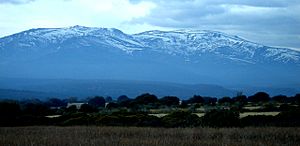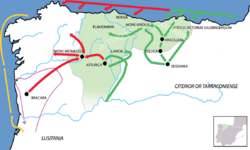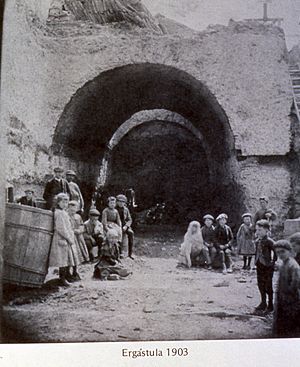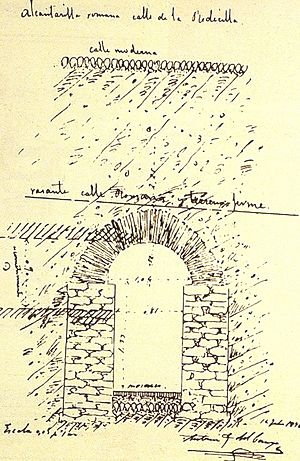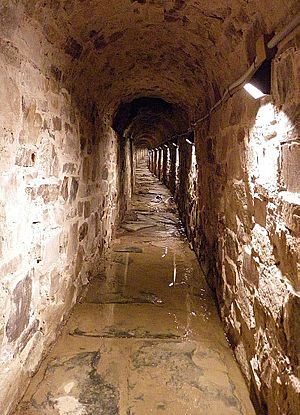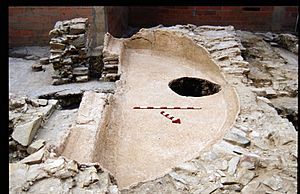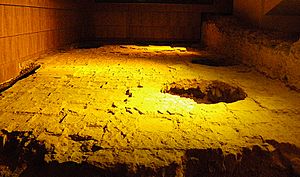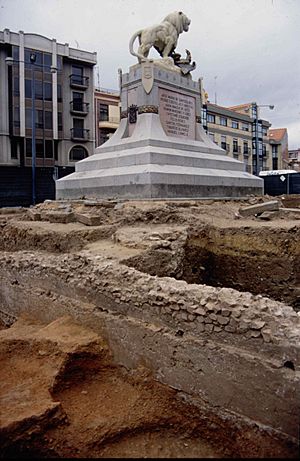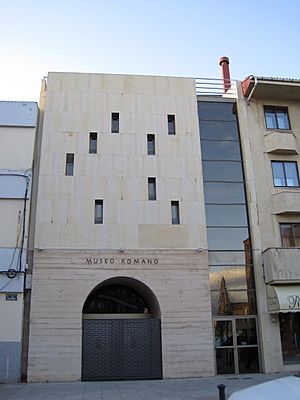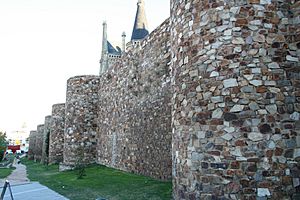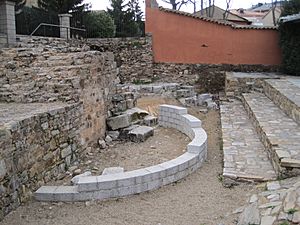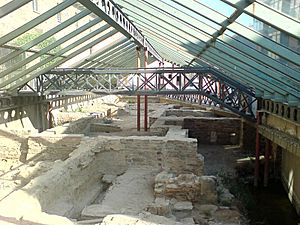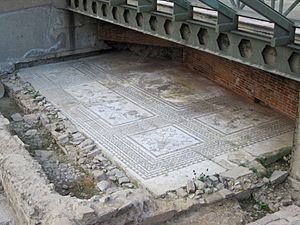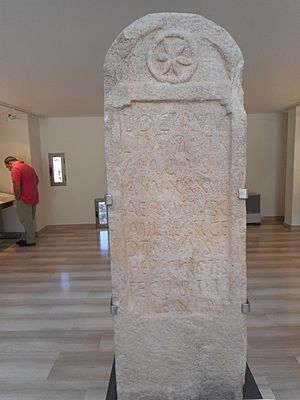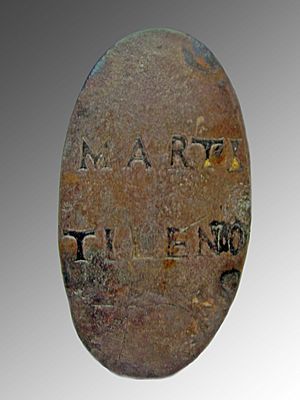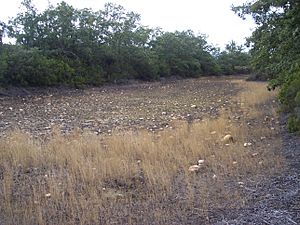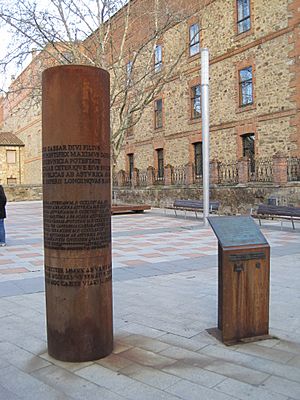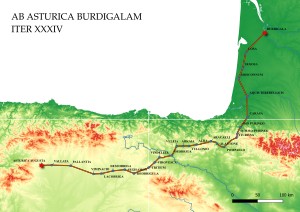Asturica Augusta facts for kids
|
Roman City
|
|
 |
|
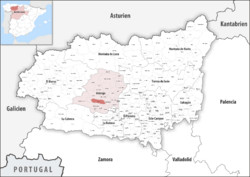
Location of Asturica Augusta (now Astorga)
|
|
| Location | Spain |
|---|---|
| Region | Country: Roman Empire Province: Tarraconensis (since 298, Gallaecia) |
| Coordinates | 42°27′32″N 6°03′48″W / 42.45889°N 6.06333°W |
| History | |
| Founded | Around 14 B.C. |
| Site notes | |
| Designation | Current equivalent: Astorga, Spain |
| Military unit: Legio X Gemina, until the beginning of the 1st century. | |
Asturica Augusta was an important Roman city in what is now Astorga, in the province of León, Spain. It started as a military camp for the Legio X Gemina (a Roman legion) around 14 B.C. Later, in the early first century, it grew into a civilian city. It became the capital of the Asturicense district within the Roman province of Tarraconense.
The city was built on a hill, giving it a great view over the land from the mountains to the plains. In the first and second centuries, Asturica Augusta became very important. This was because it controlled the gold mines in the northwest of the peninsula. It was also a major hub for roads, connecting it to other key Roman cities in Roman Spain.
Today, the old Roman city lies hidden beneath modern Astorga. Some of its ancient structures that have been found include the Roman Ergastula, two bath complexes, and the sewage system. There's also a house with a famous mosaic called the "Mosaic of the Bear and the Birds."
Contents
Where was Asturica Augusta?
The city of Astorga is located in the northwest part of the Duero River basin. The area around it has gentle hills and plains. The city itself was built on a high point, about 870 meters (2,850 feet) above sea level. This spot was where the Jerga and Tuerto rivers met.
Astorica Augusta was on the edge of the central plateau of Spain. To the north were the Cantabrian Mountains. To the east were the plains of the Duero basin. To the west were the mountains of León, including Mount Teleno. This mountain was a special religious place for both the local Asturians and the Romans.
The fertile river plains were perfect for farming, especially along the Tuerto River. There was also plenty of stone nearby, like quartzite, which was used for building. The city was also close to gold mines in the mountains. These mines, like Las Médulas, were a big reason why the city was founded here.
What Ancient Writers Said
Many ancient historians mentioned Asturica Augusta. Pliny the Elder, a Roman writer, visited the city around 73 A.D. He described it as a "magnificent city."
Following them are the twenty-two peoples of the Asturians, divided into Augustans and Transmontans, with Asturica, a magnificent city: among them are the Gigurians, the Pesicans, the Lancians, and the Zoelas. The number of freemen in the whole population reaches two hundred and forty thousand.
—Pliny the Elder, Natural History, 3, 28
This description likely came from the city's growth due to gold mining. Later, in the 2nd century, Claudius Ptolemy called Asturica the capital of the Amachians in his book Geographia. In the 3rd century, Dion Cassius wrote about cities founded by Emperor Augustus. The Antonine Itinerary, a Roman road guide, listed Asturica as a stop on several important roads. The Ravenna Cosmography also mentioned it in its travel routes. Bishop Cyprian of Carthage also wrote about the city.
Later, bishops like Hydatius (5th century) and Saint Isidore (6th-7th centuries) mentioned Asturica. Bishops from Asturica also signed documents at several important church councils.
Inscriptions and Writings
We know about 83 inscriptions found in Astorga. Another 21 were found nearby, and 7 more from other parts of Spain are connected to the city. Most of these inscriptions (64) are from tombs. Others (17) are dedications to gods or for special events. The oldest ones are from the first century and talk about military topics, especially the Legio X Gemina.
Later inscriptions from the 2nd and 3rd centuries mention important government jobs. These include Legati (governors), Procuratores Augusti (officials managing imperial property), and Praeses Provinciae (provincial governors). Two inscriptions are even in Greek.

Some inscriptions also mention local city officials like magistratus and flamines. A very important find is the Tablet of Hospitality of Astorga, also known as the Pact of the Zoelas. This agreement was confirmed in Asturica in 152 A.D. It mentions a grammaticus (a learned person) and an avium inspex (a fortune teller who read bird flights). The Greek inscriptions and names like Lyda and Taumasto show that people from other places, especially the East, lived in Asturica.
Inscriptions also tell us about the gods worshipped there. People worshipped the emperor, which showed their loyalty to Roman power. They also worshipped the Capitoline Triad (Jupiter, Juno, and Minerva) and the goddess Fortuna.
History of Asturica Augusta
Before the Romans Arrived
For a long time, people thought Astorga had a pre-Roman origin. This was because the modern city's layout didn't look like a typical Roman planned city. Manuel Gómez-Moreno first suggested this in 1905, pointing to the city's high location. Later, José María Luengo tried to prove this with archaeological finds. He mentioned a gold necklace, Roman bronze rings, Iberian coins, and a carved stone.
Another reason for thinking it was pre-Roman was Claudius Ptolemy's mention of Asturica as a city of the Asturians. He said it was the capital of the Amachus people. However, even though other Iron Age settlements were found nearby, excavations in Astorga itself haven't found clear proof of a pre-Roman town on the hill. These ideas about a Celtic origin were popular in the 19th and early 20th centuries.
Rome Arrives
Rome first came into contact with northwest Spain in the 2nd century B.C. The Cantabrian Wars at the end of the 1st century B.C. finally brought the whole northwest region under Roman control. This was part of Emperor Augustus' plan to secure the Roman Empire's borders.
The first Roman attack was in 29 B.C. led by Statilio Tauro. Augustus himself arrived in 26 B.C. The Roman army was huge, with about 77,000-80,000 soldiers from many legions. These included the Legio I Augusta, II Augusta, IV Macedonica, V Alaudae, VI Victrix, IX Hispana, and X Gemina.
The main war, the Bellum Cantabricum, began in 26 B.C. The Romans defeated the Cantabrians and Asturians. Finally, in 19 B.C., Marco Vipsanio Agrippa led the last campaign, completing Rome's control over the region.
Military Beginnings
Asturica Augusta's founding is linked to how Augustus organized the land after the Cantabrian Wars. He put in place new rules for administration, politics, and taxes to strengthen Roman power. Manuel Gómez-Moreno first suggested in the early 20th century that the city had a military origin, with the Legio X Gemina stationed there.
Archaeology has confirmed this military beginning. In the northwest part of the hill, two parallel ditches were found. These were part of the legionary camp's defenses, similar to those found in other Roman camps. Other finds like Roman pottery, coins, and military clothing parts also show this military presence. The size of the ditches suggests it was a camp built after the main wars, around 15-10 B.C.
So, a military base was set up on this strategic hill around 15-10 B.C. Its job was to watch over and control the newly conquered land. The Legio X Gemina was the unit stationed there. This legion was famous in Roman history, having fought in the Gallic Wars and other campaigns. It stayed in Spain until 63 A.D., then moved to other parts of the empire.
Early Roman Empire: The City is Born
See also: Early Roman Empire
Archaeological digs show how Asturica Augusta changed from a military camp to a civilian city. Around the end of Tiberius' rule and the start of Claudius' rule (early 1st century A.D.), military structures were replaced by civilian ones. For example, the camp's defensive ditch was filled in during Claudius' time. This change likely happened when the city became the capital of its district (conventus) and when the gold mines in its area started to be heavily used.
Even though some thought Roman influence was limited in northwest Spain, Asturica Augusta shows strong Roman development. The forum, a public space for religious, political, and economic activities, is a good example. It shows that Asturica was an important center for state administration and taxes, not just a local town. Also, a plaque dedicated to Mars Tilenus shows how Romans blended their gods with local ones.
Late Roman Empire: The End of Roman Rule
In the 3rd century, the Roman Empire reorganized its provinces. Asturica Augusta became part of the new province of Gallaecia, with its capital at Bracara Augusta. A new city wall, about two kilometers long, was also built. Parts of this wall, like the Roman Gate, can still be seen today. However, when gold mining stopped around the time of Emperor Diocletian, the city began to decline.
Astorga was one of the first places in Spain to have a Christian community. An old Roman-Christian tomb (sarcophagus) found nearby proves this. By the mid-3rd century, it was an important church center, with Basilides as its first bishop around 249 A.D. Cyprian of Carthage mentioned Christian communities in Astorga, Zaragoza, Merida, and Leon in 253-254 A.D. Bishop Decentius from Astorga attended the Council of Elvira in 300 A.D., showing the early organization of Christians there.
However, Christianity faced challenges from barbarian invasions and new religious ideas like Priscillianism and Manichaeism. Bishops like Hydatius and Saint Toribius fought against these ideas. After the execution of Priscillian in 385 A.D., the bishops of Astorga converted to Catholicism.
After the barbarian invasions, the Suevi people settled in Gallaecia around 410 A.D. This ended Roman rule over Asturica Augusta. The city suffered its first destruction or looting by the Suevi leader Hermeric.
Finding the Past: Archaeology
Interest in Astorga's past began with the discovery of Roman inscriptions. In the 1830s, the city council created a public garden and placed these inscriptions there. Early studies focused on these writings.
In 1863, parts of the Roman sewer system were found and even put back into use. A historian, Matías Rodríguez, reported finding a paved Roman street in 1896.
Official archaeological digs started in 1946 when José María Luengo studied the sewer in the Synagogue Garden. He continued to find various Roman remains throughout the city.
Later, Tomás Mañanes led excavations. In the 1970s, he found the only known Roman gate of the city near the Episcopal Palace. In 1984, he discovered the Termas Mayores (Major Baths).
Since 1984, with new government support, archaeological work in Astorga greatly increased. Now, any building site within the old city walls is excavated before new construction. By 2002, over 100 sites had been studied, providing much information about the Roman city.
These discoveries are not just for scientists. Some findings are preserved in situ (in their original place) and are part of Astorga's "Roman Route" for tourists. This route was reopened in 2009 after being made into a museum.
What Remains Today
The Roman city of Asturica Augusta covered about 26 hectares (64 acres) and was surrounded by a wall 2,200 meters (7,200 feet) long. The city plan wasn't a perfect rectangle because of the hill's shape. This led to two different street layouts: a grid pattern in the north and streets parallel to the eastern boundary in the south.
The Sewer System
Such an interesting find was immediately put to use, and today the population has a service that would never have been provided if chance had not come across it.
—Historia de Astorga. León
The Roman sewer system was found by chance in 1863. It collected dirty water from the city and emptied it into the Jerga River. More branches were found later. In 1896, a builder named A. G. del Campo documented a paved street with a sewer.
He described the sewer as having masonry walls 1.10 meters (3.6 feet) high and 0.60 meters (2 feet) thick. The channel was 0.90 meters (3 feet) wide, and the gallery was 1.50 meters (5 feet) high. It had a semicircular vault roof. Many sections of the Roman sewers are still used for the modern city's drainage today.
Roman cities built after conquests often had good sanitation systems as part of their plan. Asturica Augusta's sewers followed the street layout, which helps us understand the city's original design. Different parts of the sewer have different roof styles (vaulted or flat), suggesting they were built at different times, perhaps during the Julio-Claudian and Flavian periods.
Roman Baths
Public baths were not just for washing in Roman cities. They were also important places for people to meet and relax. Asturica Augusta had two main public bath complexes: the Termas Mayores (Major Baths) and the Termas Menores (Minor Baths).
The Termas Mayores were found in 1984 in the city center. They had two main building periods: one from the mid-1st century to the mid-3rd century, and another from the 5th century after a big renovation. These baths included a large cold room (frigidarium), warm rooms (tepidaria), and hot rooms (sudatoria) with underfloor heating.
The Termas Menores were found in the early 1980s in the southeastern part of the city. They also went through several building phases from the mid-1st century to the mid-2nd century. These baths are well-preserved and include a frigidarium, tepidarium, sudatorium, and two hot rooms (caldaria), along with furnace rooms (praefurnia).
The Forum
The forum was the most important public space in any Roman city. It was where religious, political, and economic activities happened. It showed how Roman culture was spreading, especially in newly conquered areas. Asturica Augusta's forum was on a high part of the hill, in the southern end, partly under the modern Plaza Mayor. It covered a huge area of over 31,000 square meters (7.6 acres).
The forum had a double portico (a covered walkway with columns) with semicircular and rectangular spaces opening off it. A building with a semicircular end, paved with decorative stone (opus sectile), was at the western edge. This building was likely an Aedes Augusti (a temple for imperial worship) or the seat of the city council (curia).
In the center of the forum was the Roman Ergastula. This was a long gallery, 50 meters (164 feet) long, with a barrel vault roof. It was probably the foundation for a larger building, perhaps an Ara Augusta (an altar dedicated to the emperor).
Some experts believe this whole complex might not have been just a forum. It was much larger than typical Roman forums. Also, some structures might have been there before the city was planned, perhaps from the time of the Legio X Gemina military camp. For example, stones with the inscription "LXG" (Legio X Gemina) were found in a nearby building.
Archaeological work also found remains of the basilica (a large public hall) at the eastern end of the forum. This included a semicircular apse and columns.
The City Wall
Archaeological digs have shown that Asturica Augusta had several defensive walls over time. The first was a fence or vallum built by the soldiers of the Legio X Gemina. Ditches were found at its base to make it stronger.
The second wall was made of stone. It was built after the military camp became a civilian town. This wall was 2.5 meters (8 feet) wide and had round towers. It was torn down, at least partly, in the mid-1st century. Its construction likely happened between the reigns of Tiberius and Claudius.
A third wall was built later, probably between the late 3rd and early 4th centuries. This was a time when many Roman cities fortified themselves due to political instability. This wall was made of irregular quartzite blocks mixed with mortar. Its shape followed the hill's natural contours. Today, the wall is not in its original state due to many repairs and restorations over the centuries.
Of all the gates the city had, only one from the Roman period has been found. It's near what's called the Iron Gate today. This gate had two semicircular towers, 8.20 meters (27 feet) in diameter, made of large stone blocks. They left a four-meter (13-foot) wide paved road between them. Other gates included Puerta de Rey, Puerta del Sol, Puerta del Obispo, and Postigo de San Julián.
Roman Homes
Archaeologists haven't been able to fully excavate any single Roman house in Astorga. This is because the modern city's layout is different from the Roman one. However, we know that Roman homes in Asturica used stone for their walls, often combined with adobe or rammed earth. The stone was mainly quartzite and slate, which were easily found nearby.
Other materials like clay were also used for building. Tiles (tegulae) and bricks (later coctus) were common, especially in the bath complexes for the hypocaust pillars.
The first excavations of a house happened in 1954. A house was found with two complete rooms and parts of three others. Many walls still had paintings, known as Pinturas Pompeyanas, from the first half of the 2nd century.
Domus of Great Peristyle
This large house likely covered more than one city block (insula). Its oldest parts date from the Julio-Claudian period to the mid-1st century. A key feature was a space called an impluvium, which helped organize the house.
A later phase of the house had a peristyle (a courtyard surrounded by columns) with six columns on each side. A small canal around the portico collected rainwater. In the center of the peristyle was a large fountain. The rooms of the house were built around these galleries.
This house also had its own bath area. It had three rooms with hypocaust (underfloor heating) for hot and warm baths. There was also a cold room (frigidarium) with a decorative stone floor.
Domus of the Mosaic of the Bear and the Birds
This house is in the southeastern part of the city and is one of the most important homes found in Astorga. It's known for its high-quality materials, different types of floors (like opus signinum and opus tesselatum), and wall paintings. It also had its own bath complex with a hot room (caldarium), warm room (tepidarium), and cold room (frigidarium).
The most famous part is the mosaic floor in one of the rooms, probably a dining room (triclinium) or living room (oecus). Dating from the early Severan dynasty, it shows four vases with flowers in the corners and birds between them. These designs surround a central part with ten medallions showing animals like a bear and a leopard.
The house was built around a central peristyle. It was renovated several times, with a major change around the late 1st or early 2nd century. This renovation moved the public road and used an old sewer space for the new bath complex.
Domus of the Pavement of Opus Signinum
This house, near the northwest corner of the forum, shows how the city developed in the 1st century. Its oldest parts faced northeast-southwest, like other buildings in the western city. This layout lasted until the mid-1st century. Then, during the Flavian dynasty, the house was redesigned, and its rooms were organized around a peristyle.
A room with an opus signinum floor belongs to the first period of this house, dating from the late rule of Tiberius (14-37 A.D.) and early rule of Claudius (41-54 A.D.).
Domus of the Denarii
This house is named after 28 denarii (Roman coins) found where it was built. Most of these coins were from the time of Augustus and Tiberius. The house was likely built around a rectangular pond, with a corridor leading to different rooms.
A small room with a slate floor and a drain leading to the house's sewer system was found. This might have been an atrium with its impluvium (a basin for collecting rainwater). The house also had running water, with a lead pipe and a bronze tap. This house dates from the mid-1st century (Flavian period) and was used until the 5th century.
Outside the Walls
Outside the city walls, archaeologists found a wall at the foot of the western wall. This wall likely held back material from the city above. A large amount of materials and ash levels were found in a trench, suggesting it was used as a dump.
Several cemeteries were also found outside the city walls, often by accident. In 1888, a masonry tomb with a glass urn was found. In 1923, several tombs made of tiles were found. More burials were found in 1935. In the 1980s, a tombstone was found with a cremation cemetery.
In 2002, during gas pipeline work, a burial area was found. Three brick tombs held two men and a woman, along with grave goods. Another burial, made of boulders, held a fetus. Two cremations were also found.
Area of Influence
Archaeological work has also been done in the surrounding area, like at the castro de la Magdalena (an ancient fortified settlement) near Castrillo de los Polvazares. Excavations there found evidence of a prehistoric settlement from the late Bronze Age to the early Iron Age. This settlement had huts and storage pits.
Later, the site was occupied in Roman times. In its upper part, different phases of Roman occupation were found. The first was before the change of era, with signs of burning and early Roman materials. The second, in the mid-1st century, involved building a wall, streets, and buildings. The third phase, in the 2nd or 3rd centuries, saw the destruction of the wall.
How the City Was Governed
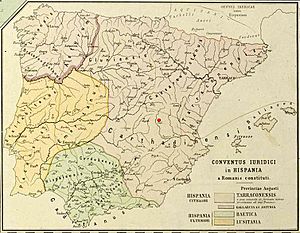
After the Romans arrived, Asturica Augusta became the administrative center for a large area called the Asturicense conventus. This meant it controlled the mining of resources and handled taxes and political matters. It was traditionally thought that Asturica was a civitas peregrina, a city for non-Roman citizens. These cities had a local council that collected taxes and managed justice, and they had to provide workers for the mines.
However, some experts now believe Asturica might have been a municipium, a city with more Roman rights. This is because a duumviro (a type of Roman official) was mentioned in an old road guide. Also, it seems unlikely that such an important city, the capital of a judicial district, would not have gained municipal status, especially when other nearby cities did. This change to municipal status might have happened during Augustus' trip to Spain between 15 and 13 B.C.
Inscriptions found in the city also support this idea. They mention various Roman government positions, like legati (governors) and procuratores Augusti (officials managing imperial property and mines). There are also mentions of local officials like magistratus and Flamines. All these show that Asturica played a central role in northwest Spain and attracted people from all over. The fact that the Pact of the Zoelas was signed there also confirms its importance.
The tabula lougeiorum suggests there was an Ara Augusta (a center for worshipping the emperor) where the city was later founded. While this specific cult hasn't been fully confirmed by archaeology, the worship of the Capitoline Triad (Jupiter, Juno, and Minerva) is mentioned in six inscriptions. Pliny's description of the city as "magnificent" was likely due to its growth from gold mining, which brought many officials, merchants, and immigrants.
Religion in Asturica Augusta
There are no direct mentions of local Asturian gods within the city of Astorga itself. However, nearby, the god Caraedudi was worshipped. Also, near Mount Teleno, a plaque dedicated to Marti Tileno was found. Tilenus was a local god of the mountain, whom the Romans connected with their god Mars. The absence of local gods in Astorga itself is likely because it started as a Roman military camp with very few local people.
Roman and Greek Gods
Since Astorga began as a Roman camp, Roman and adopted Greek gods were worshipped there. We know about several gods who had cults in the city:
- Mars: Worshipped from the early 3rd century, as he was the god of war who helped the camp. In Astorga, he was known as Gradivo (who also helps harvests) and Sagato (referring to the soldiers' cloaks).
- Mercury: God of trade and roads. He appears only once in Astorga, on a road leading to the gold mines of Las Médulas.
- Cult to the Emperor and Empress: This worship was natural because Asturica was the capital of a judicial district, where many officials lived. Julia Domna, an empress, received special dedications as "mother of the emperor, mother of the senate, of the camp, and of the homeland." This cult was also linked to the goddesses Minerva and Juno.
- Proserpina: Daughter of Ceres, she appears in Astorga with the unique title of Invicta (Unconquered).
- Apollo: God who protected the emperor. In Astorga, he was linked to Granno, a Celtic god meaning "shining like the garnet or the sun." This Celtic god had a sanctuary in Trier.
The god Aesculapius and his son Telesphoros, who were related to medicine and healing, were also worshipped in Astorga.
Economy and Food
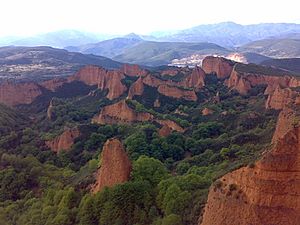
Besides the famous Las Médulas mines in Bierzo, Asturica Augusta controlled many other gold mines throughout the Maragatería region. Traces of these mines can still be seen today.
Gold mining existed before the Romans, but the Roman Empire greatly expanded it, especially near Mount Teleno. After the Legio X Gemina settled there, the area was made peaceful, and forts were built to support mining.
The mining work was done by local people under the control of Roman army units. Roman engineering allowed for huge amounts of gold to be produced, up to six tons per year. This was impressive, considering the low gold content in the rock.
The mining process involved building canals to bring water from rivers to the mines. This water was stored in pools, like those at the Fucarona mine. Then, the water was released under high pressure over the ground and into tunnels. This washed away the material, and the gold was collected. This method was called ruina montium (mountain collapse).
... the mountains are mined along a great extension by means of galleries made by the light of lamps ... When the work of preparation is finished, the shoring of the vaults is demolished from the furthest away; the collapse is announced and the watchman placed at the top of the mountain is the only one who notices it. Consequently, he gives orders with shouts and gestures to warn the workmen and, at the same time, he himself flies down. The mountain, cracked, collapses by itself in the distance with a roar that cannot be imagined by the human mind, as well as with an incredible displacement of air...
—Pliny the Elder, Natural History
In the Maragatería region, the arrugia system was common. This created open mining sites, forming artificial valleys or lagoons. The waste materials, called murias, formed large cones that changed the landscape. The gold-containing mud was washed in gently sloping channels to separate the gold.
The mines were most active during the Flavian dynasty (late 1st century) until the mid-3rd century, when they declined. The Fucarona mine, near Rabanal Viejo, is a well-preserved example. You can still see the mining area, water channels, and four storage pools there.
Other important mining sites include Fucochicos (between Luyego and Priaranza de la Valduerna), Corona de Pedredo, and Cernea Lagoon near Santa Colomba de Somoza.
Regarding food, a 2010 study found over a thousand mollusk remains, mostly oysters, from Astorga's Roman period. This shows that oysters were an important part of the diet for the wealthy people in Asturica. It also means there was trade with coastal areas to bring these seafood items inland.
Roads and Communication
See also: Vía de la Plata
Asturica Augusta was always a key point for travel. It was a necessary stop to reach the Bierzo region and Galicia, passing through mountain routes. Its role as an administrative center also required a strong network of roads, first for military use, then for trade. Many ancient documents mention the roads that passed through the city. The most important is the Antonine Itinerary, written in the 3rd century. It lists several routes for Asturica Augusta:
| Road | Route |
|---|---|
| Via XVII or Item a Bracara Asturicam | Asturica Augusta - Bracara Augusta |
| Via XVIII or Item alio itinere a Bracara Asturica | Asturica Augusta - Bracara Augusta |
| Via XIX or Item a Bracara Asturicam | Asturica Augusta - Lucus Augusti - Bracara Augusta |
| Via XX or Item per loca maritima a Bracara Asturicam | Asturica Augusta - Lucus Augusti - Bracara Augusta |
| Via XXVI or Item ab Asturica Caesaraugusta | Asturica Augusta - Caesaraugusta |
| Via XXVII or Ab Asturica per Cantabria Caesaraugusta | Asturica Augusta - Caesaraugusta |
| Via XXXII or Item ab Asturica Tarracone | Asturica Augusta - Tarraco |
| Via XXXIV or Ab Asturica Burdigalam | Asturica Augusta - Burdigala |
Among these, Via XXVI (part of the Vía de la Plata) and Via XXXIV were very important. Via XXXIV later became a pilgrimage route to Santiago de Compostela. Another document, the Tablas de Barro (Clay Tablets), found near Astorga, also describes roads from Asturica to other cities. These tablets were confirmed as authentic in 2012. Other documents like the Ravenna Cosmography and the Tabula Peutingeriana (a 4th-century map copy) also mention Asturica.
See Also
 In Spanish: Asturica Augusta para niños
In Spanish: Asturica Augusta para niños
- Asturicense Convent
- Roman Museum of Astorga
- Antonine Itinerary


